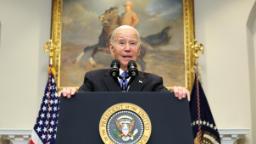
Washington
CNN
—
During a Friday speech about the September jobs report, President Joe Biden delivered a rapid-fire series of three false or misleading claims – falsely saying that he has cut the debt, falsely crediting a tax policy that didn’t take effect until 2023 for improving the budget situation in 2021 and 2022, and misleadingly saying that he has presided over an “actual surplus.”
At a separate moment of the speech, Biden used outdated figures to boast of setting record lows in the unemployment rates for African Americans, Hispanics and people with disabilities. While the rates for these three groups hit record lows earlier in his presidency, he didn’t acknowledge that they have all since increased to non-record levels – and, in fact, are now higher than they were during parts of Donald Trump’s presidency.
Here’s a fact check.
Biden said in the Friday speech that Republicans want to “cut taxes for the very wealthy and big corporations,” which would add to the deficit. That’s fair game.
But then he added: “I was able to cut the federal debt by $1.7 trillion over the first two-and-a – two years. Well remember what we talked about. Those 50 corporations that made $40 billion, weren’t paying a penny in taxes? Well guess what – we made them pay 30%. Uh, 15% in taxes – 15%. Nowhere near what they should pay. And guess what? We were able to pay for everything, and we end up with an actual surplus.”
Facts First: Biden’s claims were thoroughly inaccurate. First, he has not cut the federal debt, which has increased by more than $5.7 trillion during his presidency so far after rising about $7.8 trillion during Trump’s full four-year tenure; it is the budget deficit (the one-year difference between spending and revenues), not the national debt (the accumulation of federal borrowing plus interest owed), that fell by $1.7 trillion over his first two fiscal years in office. Second, Biden’s 15% corporate minimum tax on certain large profitable corporations did not take effect until the first day of 2023, so it could not possibly have been responsible for the deficit reduction in fiscal 2021 and 2022. Third, there is no “actual surplus”; the federal government continues to run a budget deficit well over $1 trillion.
CNN has previously debunked Biden’s false claims about supposedly having cut the “debt” and about the new corporate minimum tax supposedly being responsible for deficit reduction in 2021 and 2022. The White House, which declined to comment on the record for this article, has corrected previous official transcripts when Biden has claimed that the debt fell by $1.7 trillion, acknowledging that he should have said deficit.
As for Biden’s vague additional claim that “we end up with an actual surplus,” a White House official said Friday that the president was referring to how the particular law in which the new minimum tax was contained, the Inflation Reduction Act of 2022, is projected to reduce the deficit. But Biden did not explain this unusual-at-best use of “surplus” – and since he had just been talking about the overall budget picture, he certainly made it sound like he was claiming to have presided over a surplus in the overall budget. He has not done so.
Matthew Gardner, a senior fellow at the Institute on Taxation and Economic Policy, a liberal think tank, said in response to the White House explanation: “Well he didn’t say ‘budget surplus’ I suppose. But in federal budget conversations, the word surplus has a very specific meaning. It doesn’t mean ‘additional,’ it means revenues exceed spending.” He noted earlier Friday that there hasn’t been a federal budget surplus since 2001.
It’s worth noting, as we have before, that Biden’s Friday comments would be missing key context even if he had not inaccurately replaced the word “deficit” with “debt.” It’s highly questionable how much credit Biden himself deserves for the decline in the deficit in 2021 and 2022. Independent analysts say it occurred largely because emergency Covid-19 relief spending from fiscal 2020 expired as scheduled – and that Biden’s own new laws and executive actions have significantly added to current and projected future deficits. In addition, the 2023 deficit is widely expected to be higher than the 2022 deficit.
More on the corporate minimum tax
When Biden spoke Friday about “those 50 corporations that made $40 billion, weren’t paying a penny in taxes,” he was referring, as he has in the past, to an Institute on Taxation and Economic Policy analysis published in 2021 that listed 55 companies the think tank found had paid no federal corporate income taxes in their most recent fiscal year.
But it was imprecise, at best, for Biden to say Friday that we made “them” pay 15% in taxes. That’s because the new 15% minimum tax applies only to companies that have an average annual financial statement income of $1 billion or more – there are lots of nuances involved; you can read more details here – and only 14 of the 55 companies on the think tank’s list reported having US pre-tax income of at least $1 billion. In other words, some large and profitable companies will not be hit with the tax.
The federal government’s nonpartisan Joint Committee on Taxation projected last year that the tax would shrink deficits by about $222 billion through 2031, with positive impacts beginning in 2023. Gardner said Friday that he fully expects the tax to play a role in reducing deficits going forward, but he said its deficit-reducing impact “might be lower than expected” in 2023 because the Treasury Department – which has been the subject of intense lobbying from corporations that could be affected – has taken so long to implement the details of the law that the Internal Revenue Service ended up waiving penalties on companies that don’t make estimated tax payments on it this year.
Regardless, Gardner said, “The minimum tax did not reduce the deficit at all in fiscal years 2021 or 2022 because it didn’t exist during those years.”
Early in the Friday speech, Biden boasted of statistics from the September jobs report that was released earlier in the day. But then he said, “We’ve achieved a 70-year low in unemployment rate for women, record lows in unemployment for African Americans and Hispanic workers, and people with disabilities – folks who’ve been left behind in previous recoveries and left behind for too long.”
Facts First: Three of these four Biden unemployment boasts are misleading because they are out of date. Only his claim about a 70-year low for women’s unemployment remains current. While the unemployment rates for African Americans, Hispanics and people with disabilities did fall to record lows earlier in Biden’s presidency, they have since increased – to rates higher than the rates during various periods of the Trump administration.
Women: The seasonally adjusted women’s unemployment rate was 3.4% in September. That’s a tick upward from the 3.3% rate during two previous months of 2023, but it’s still tied – with two months of the Trump administration – for the lowest for this group since 1953, 70 years ago.
African Americans: The seasonally adjusted Black or African American unemployment rate was 5.7% in September, up from the record low of 4.7% in April. The current 5.7% rate is higher than this group’s rates during four months of 2019, under Trump.
Hispanics: The seasonally adjusted Hispanic unemployment rate was 4.6% in September, up from the record low of 3.9% from September 2022. The current 4.6% rate is higher than this group’s rates for every month from April 2019 through February 2020 under Trump, plus a smattering of prior Trump-era months.
People with disabilities: The unemployment rate for people with disabilities, ages 16 and up, was 7.3% in September, up from a record low of 5.0% in December 2022. (The figures only go back to 2008, so the record was for a period of less than two decades.) The current 7.3% rate is higher than this group’s rates during eight months of the Trump presidency, seven of them in 2019.























